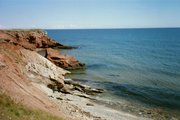Magdalen Islands
|
|
Magdalen-lighthouse.jpg
The Magdalen Islands (French, Îles-de-la-Madeleine) are an archipelago in the Gulf of Saint Lawrence. Though closer to Prince Edward Island and Nova Scotia, the islands belong to Quebec. There are nine major islands - Alright, Amherst, Brion, Coffin, East, Entry, Grindstone, Grosse, and Wolf - and numerous islets. Administratively, they make up the Les Îles-de-la-Madeleine Regional County Municipality.
Jacques Cartier was the first European to visit the islands, in 1534.
In 1755, the islands were inhabited by French-speaking Acadians. When the British expelled the Acadians from the rest of what is now the Maritime Provinces of Canada, they did not come as far as the Magdalen Islands. To this day, many inhabitants of the Magdalen Islands (Madelinots) fly the Acadian flag and think of themselves as distinct from the Québécois.
Another segment of the population comes from survivors of the over 400 shipwrecks on the islands. The islands are the location of some of Quebec's oldest English-speaking settlements, and although the majority of anglophones have since been assimilated with the francophone population or migrated elsewhere, there are still English-speaking settlements, many located on Entry Island.
Magdalen.jpg
Lighthouses were eventually set up, and this reduced the number of shipwrecks, but there are still many old hulks on the beaches and under the waters.
In the 2001 Census, the archipelago was found to support a population of 12,824 — down from 13,991 in 1991 — whose main occupations include fishing and sealing.
Tourism is now a major industry in the Magdalen Islands, as in Prince Edward Island, Nova Scotia and New Brunswick, partly because of the depletion of the fish in the area. The islands are particularly appealing to French-speaking Québécois, who can enjoy the ocean and speak their native language. The island has many kilometers of white sand beaches, along with steadily eroding sandstone cliffs. It is an excellent destination for bicycle camping and sea kayaking.
Until the 20th century, the islands were completely isolated during the winter, since the pack ice made the trip to the mainland impassable by boat. The inhabitants of the island could not even communicate with the mainland. In the winter of 1910, they sent an urgent request for help to the mainland by writing many letters and sealing them up inside a molasses barrel (or puncheon), which they set adrift. When this reached the shore, on Cape Breton Island, the government sent out an icebreaker to bring aid. Within a few years, the Magdalens got one of the new wireless telegraph stations so that the inhabitants could at least have some communication in the winter. The puncheon is now famous, and every tourist shop sells replicas.
See also
External links
- Magdalen Islands tourist association (http://www.tourismeilesdelamadeleine.com)
- The official tourist site of the islands (http://www.ilesdelamadeleine.com/index2.htm)
- Tales from the Magdalen Islands (http://www.qcna.org/Informer/tales.html) including part of the story of the puncheon.
- Quebec tourism information on the Magdalen Islands (http://www.quebecweb.com/tourisme/ilemadeleine/introang.html) including a map (with the French names)
Template:Gaspésie-Îles-de-la-Madeleinede:Magdalenen eo:Magdalen-Insuloj fr:Les Îles-de-la-Madeleine

